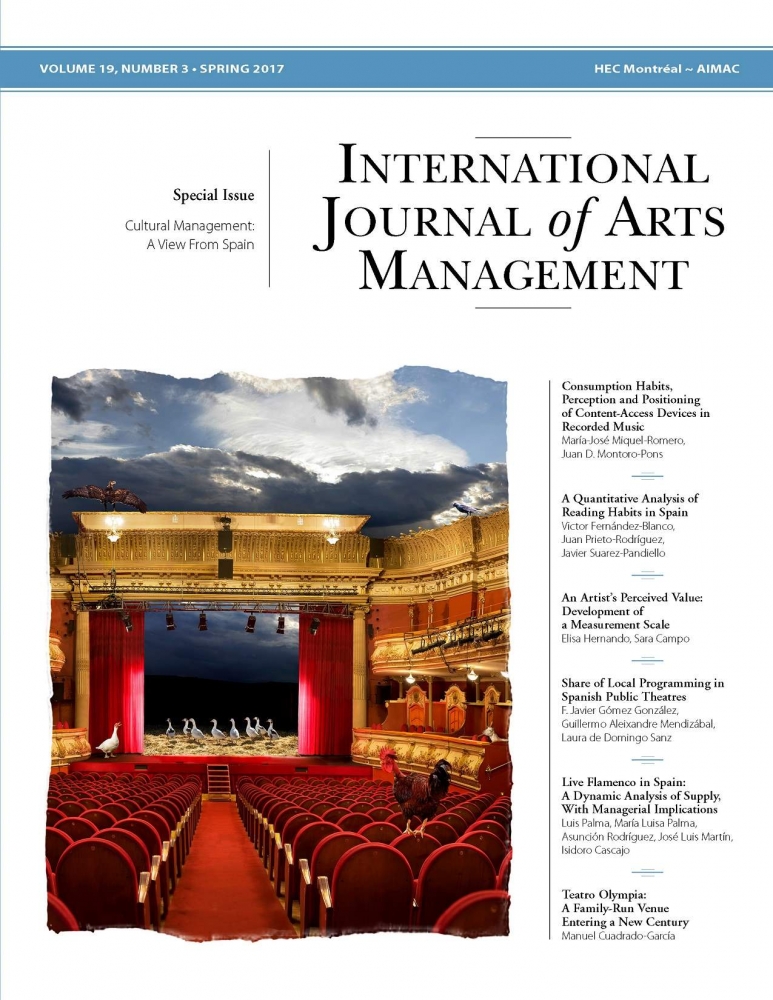IJAM Volume 19 Number 3 (PDF)
Product: Journal
$53.00 CA
FROM THE GUEST EDITOR
Cultural Management: A View From Spain
Manuel Cuadrado-García, University of Valencia, Spain
On a warm summer evening in Dallas, Texas, during AIMAC’s 10th International Conference on Arts and Cultural Management, a group of participants from Spain met informally. We discussed how wonderful it was to see each other at this type of conference and how useful it would be to share our work more often and at less of a distance from our home bases. A few months later, in autumn 2009, we held the first Workshop on Cultural Economics and Management, a small but interesting gathering of Spanish researchers in those fields, also open to our foreign colleagues. The sixth edition of the Workshop, held in Madrid in 2014, was co-branded by AIMAC. Considering the large number of papers delivered and the high quality of the presentations, AIMAC offered to devote an entire issue of IJAM to the Workshop and kindly invited me to serve as Guest Editor.
This special issue of the Journal, titled Cultural Management: The View From Spain, comprises five research articles and IJAM’s customary Company Profile. Fortuitously, each piece deals with a different type of artistic activity (recorded music, reading, visual art, performing arts, live music shows) as well as a different research category, methodological process and technique.
In the first contribution, “Consumption Habits, Perception and Positioning of Content-Access Devices in Recorded Music,” Maria-José Miquel-Romero and Juan D. Montoro-Pons analyze recorded music consumption habits as well as the positioning of reproduction devices for recorded music and opinions on the music industry. The authors find significant differences among the various segments.
Leisure reading habits as part of consumers’ decision-making process is the subject of an investigation by Victor Fernández-Blanco, Juan Prieto- Rodríguez and Javier Suarez-Pandiello. In “A Quantitative Analysis of Reading Habits in Spain,” the authors emphasize the role of cultural background and examine policies for encouraging leisure reading.
Elisa Hernando and Sara Campo, in “An Artist’s Perceived Value: Development of a Measurement Scale,” construct and define a scale for measuring the perceived value of an artist from the collector’s perspective. This could be useful for marketing agents in establishing the price of an art work based on market-demand assessment criteria.
In their article, “Share of Local Programming in Spanish Public Theatres,” F. Javier Gómez González, Guillermo Aleixandre Mendizábal and Laura de Domingo Sanz analyze preferences for local versus non-local programming of live productions in publicly funded venues, identifying some determinants.
“Live Flamenco in Spain: A Dynamic Analysis of Supply, With Managerial Implications,” by Luis Palma, María Luisa Palma, Asunción Rodríguez, José Luis Martín and Isidoro Cascajo, explores the supply of live flamenco considering both organizational aims and the nature of the show, to help the sector implement new management strategies.
Finally, in the Company Profile, “Teatro Olympia: A Family-Run Venue Entering a New Century,” Manuel Cuadrado-García describes the case of a theatre celebrating its 100th anniversary and eager to move forward, adopting new management and marketing strategies in order to better satisfy current audiences and attract new ones.
The purpose of this special issue of IJAM is to help academics, researchers, practitioners and anyone else interested in arts management to gain some insight into arts consumption and managerial strategies in Spain. We hope you enjoy reading the various research studies and observations presented in these pages.
